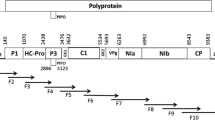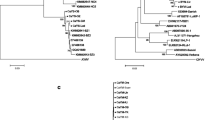Abstract
Seed transmission of Turnip yellow mosaic virus (TYMV, genus Tymovirus) was evaluated in the whole seeds and seedlings that emerged from three commercial Chinese cabbage (Brassica pekinensis) seed batches. Seedlings in the cotyledon stage and adult plants were assayed for TYMV by DAS-ELISA and confirmed by RT-PCR. The proportion of whole seeds infected with TYMV was at least 0.15 %. The seeds of the three seed batches were grown in Petri dishes, and surveyed in the cotyledon stage in trays that contained a peat:sand mixture grown in greenhouses or growth chambers, which were analysed in the cotyledon and adult stages. The seed-to-seedling transmission rate ranged from 2.5 % to 2.9 % in two different seed batches (lot-08 and lot-09, respectively). Spanish isolates derived from turnip (Sp-03) and Chinese cabbage (Sp-09 and Sp-13), collected in 2003, 2009 and 2013 in two different Spanish regions, were molecularly characterised by analysing the partial nucleotide sequences of three TYMV genome regions: partial RNA-dependent RNA polymerase (RdRp), methyltransferase (MTR) and coat protein (CP) genes. Phylogenetic analyses showed that the CP gene represented two different groups: TYMV-1 and TYMV-2. The first was subdivided into three subclades: European, Australian and Japanese. Spanish isolate Sp-03 clustered together with European TYMV group, whereas Sp-09 and Sp-13 grouped with the Japanese TYMV group, and all differed from group TYMV-2. The sequences of the three different genomic regions examined clustered into the same groups. The results suggested that Spanish isolates grouped according to the original hosts from which they were isolated. The inoculation of the Spanish TYMV isolates to four crucifer plants species (turnip, broccoli, Brunswick cabbage and radish) revealed that all the isolates infected turnip with typical symptoms, although differences were observed in other hosts.


Similar content being viewed by others
References
Assis Filho, M., & Sherwood, J. L. (2000). Evaluation of seed transmission of Turnip yellow mosaic virus and Tobacco mosaic virus in Arabidopsis thaliana. Phytopathology, 90, 1233–1238.
Benetti, M. P., & Kaswalder, F. (1983). Trasmisione per seme del virus del mosaico giallo rapa. Annali dell Istituto Sperimentale per la Patologia Vegetale, 8, 67–70.
Blok, J., Mackenzie, A., Guy, P., & Gibbs, A. (1987). Nucleotide sequence comparisons of Turnip yellow mosaic virus isolates from Australia and Europe. Archives of Virology, 97, 283–295.
Brunt, A., Crabtree, K., Dallwitz, M., Gibbs, A., Watson, L., & Zurcher, E.J. (1996). Plant Viruses Online: Descriptions and Lists from the VIDE Database. Version: 20th August 1996. URL http://biology.anu.edu.au/Groups/MES/vide/.
Campbell, R. N., Wipf-Scheibel, C., & Lecoq, H. (1996). Vector-assissted seed transmission of melon necrotic spot virus in melon. Phytopathology, 86, 1294–1298.
Dreher, T. W., & Bransom, K. L. (1992). Genomic RNA sequence of Turnip yellow mosaic virus isolate TYMC, a cDNA-based clone with verified infectivity. Plant Molecular Biology, 18, 403–406.
Fakhro, A., Von Bargen, S., Bandte, M., Büttner, C., Franken, P., & Schwarz, D. (2011). Susceptibility of different plant species and tomato cultivars to two isolates of Pepino mosaic virus. European Journal of Plant Pathology, 129, 579–590.
Gibbs, A. J., & Gower, J. C. (1960). The use of a multiple-transfer method in plant virus transmission studies: some statistical points arising in the analysis of results. Annals of Applied Biology, 48, 75–83.
Hayden, C. M., Mackenzie, A. M., & Gibbs, A. J. (1998a). Virion protein sequence variation among Australian isolates of turnip yellow mosaic tymovirus. Archives of Virology, 143, 191–201.
Hayden, C. M., Mackenzie, A. M., Skotnicki, M. L., & Gibbs, A. (1998b). Turnip yellow mosaic virus isolates with experimentally produced recombinant virion proteins. Journal of General Virology, 79, 395–403.
Hein, A. (1984). Transmission of Turnip yellow mosaic virus through seed of Camelina sativa gold of pleasure. Journal of Plant Diseases and Protection, 91, 549–551.
Herrera-Vásquez, J. A., Córdoba-Sellés, M. C., Cebrián, M. C., Alfaro-Fernández, A., & Jordá, C. (2009). Seed transmission of Melon necrotic spot virus and efficacy of seed-disinfection treatments. Plant Pathology, 58, 436–452.
Hull, R. (2002). Matthews’ plant virology (4a ed.1001 pp). San Diego: Academic Press.
Johansen, E., Edwards, M. C., & Hampton, R. O. (1994). Seed transmission of viruses: current perspectives. Annual Review of Phytopathology, 32, 363–386.
Kirino, N., Inoue, K., Tanina, K., Yamazaki, Y., & Ohki, S. T. (2008). Turnip yellow mosaic virus isolated from Chinese cabbage in Japan. Journal of General Plant Pathology, 74, 331–334.
Markham, R., & Smith, K. S. (1949). Studies on the virus of turnip yellow mosaic. Parasitology, 39, 330–342.
Mathews, R. E. F. (1980). Turnip yellow mosaic virus, CMI/AAB Descriptions of plant virus No. 230 (No. 2 revised). Kew: Commonwealth Mycology Institute/Association of Applied Biologists.
Mitchell, E. J., & Bond, J. M. (2005). Variation in the coat protein sequence of British isolates of Turnip yellow mosaic virus and comparison with previously published isolates. Archives of Virology, 150, 2347–2355.
Pagán, I., Fraile, A., Fernández-Fueyo, E., Montes, N., Alonso-Blanco, C., & García-Arenal, F. (2010). Arabidopsis thaliana as a model for the study of plant-virus co-evolution. Philosophical Transations of the Royal Society Biological Sciences, 365, 1983–1995.
Paul, H. L., Gibbs, A., & Wittman-Liebold, B. (1980). The relationships of certain Tymoviruses assessed from the amino acid composition of their coat proteins. Intervirology, 13, 99–109.
Pelikanova, J. (1990). Garlic mustard a spontaneous host of TYMV. Ochrana Rostlin, 26, 17–22.
Procházková, Z. (1980). Host range and symptom differences between isolates of Turnip mosaic virus obtained from Sisymbrium loeselii. Biologia Plantarum, 22, 341–347.
Rimmer, S. R., Shtattuck, V. I., & Buchwaldt, L. (2007). Compendium of brassica diseases (1ª Edición ed.p. 117). USA: APS press.
Rot, M. E., & Jelkman, W. (2001). Characterization and detection of several filamentous viruses of cherry: Adaptation of an alternative cloning method (DOP-PCR), and modification of an RNA extraction protocol. European Journal of Plant Pathology, 107, 411–420.
Sabanadzovic, S., Abou-Ghanem, N., Castellano, M. A., Digiaero, M., & Martelli, G. P. (2000). Grapevine fleck virus-like in Vitis. Archives of Virology, 145, 553–565.
Špack, J., & Kubelková, D. (2000). Serological variability among European isolates of Radish mosaic virus. Plant Pathology, 49, 295–301.
Špack, J., Kubelková, D., & Hnilicka, E. (1993). Seed transmission of Turnip yellow mosaic virus in winter turnip and winter oilseed rapes. Annals of Applied Biology, 123, 33–35.
Stobbs, L. W., Cerkauskas, R. F., Lowery, T., & VanDriel, L. (1998). Occurrence of Turnip yellow mosaic virus on oriental cruciferours vegetables in Southern Ontario, Canada. Plant Disease, 82, 351.
Tamura, K., Peterson, D., Peterson, N., Stecher, G., Nei, M., & Kumar, S. (2011). MEGA5: molecular evolutionary genetics analysis using maximum likelihood, evolutionary distance, and maximum parsimony methods. Molecular Biology and Evolution, 28, 2731–2739.
Author information
Authors and Affiliations
Corresponding author
Rights and permissions
About this article
Cite this article
Alfaro-Fernández, A., Serrano, A., Tornos, T. et al. Turnip yellow mosaic virus in Chinese cabbage in Spain: commercial seed transmission and molecular characterisation. Eur J Plant Pathol 146, 433–442 (2016). https://doi.org/10.1007/s10658-016-0929-3
Accepted:
Published:
Issue Date:
DOI: https://doi.org/10.1007/s10658-016-0929-3




